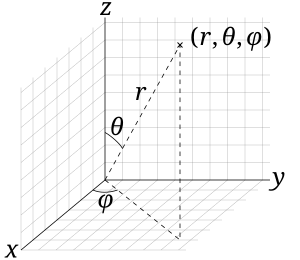
Back Koördinatestelsel Afrikaans Koordinatensystem ALS Sistema de coordenadas AN نظام إحداثيات Arabic Sistema de coordenaes AST Koordinat sistemi Azerbaijani Координаталар системаһы Bashkir Сістэма каардынат Byelorussian Сыстэма каардынат BE-X-OLD Координатна система Bulgarian

In geometry, a coordinate system is a system that uses one or more numbers, or coordinates, to uniquely determine the position of the points or other geometric elements on a manifold such as Euclidean space.[1][2] The order of the coordinates is significant, and they are sometimes identified by their position in an ordered tuple and sometimes by a letter, as in "the x-coordinate". The coordinates are taken to be real numbers in elementary mathematics, but may be complex numbers or elements of a more abstract system such as a commutative ring. The use of a coordinate system allows problems in geometry to be translated into problems about numbers and vice versa; this is the basis of analytic geometry.[3]
- ^ Woods p. 1
- ^ Weisstein, Eric W. "Coordinate System". MathWorld.
- ^ Weisstein, Eric W. "Coordinates". MathWorld.
© MMXXIII Rich X Search. We shall prevail. All rights reserved. Rich X Search